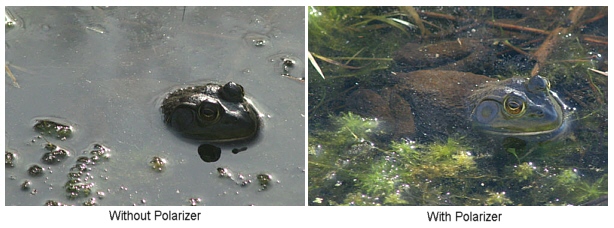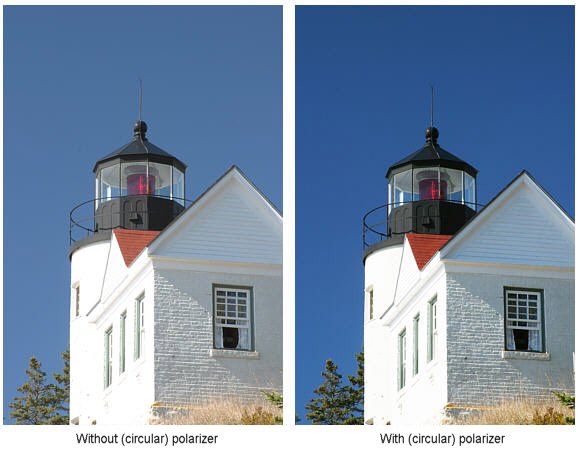

All about Polarizers - Linear and Circular
There is probably no more widely misunderstood photographic accessory than the polarizing filter and there is often confusion about how linear and circular polarizers work, what the difference is between them and when a circular polarizer is needed.
Polarization
So first let's look at polarization in general. You can think of light as traveling in waves. One way to visualize these waves is to imagine taking a length of rope and tying one end to a post. Moving the free end up and down sets up a "wave" along the rope which also moves up and down. If you think of the rope as representing a beam of light, the light would be "vertically polarized". If the free end is moved from side to side, a wave that moves from side to side is set up. Again, if this was a light beam, you could call it "horizontally polarized". Both of these are examples of plane or linear polarization.
You could also move the free end around in a circle and, if you got the timing just right, you could set up a wave that looks like a corkscrew. This is analogous to a light beam having circular polarization. You could move the free end of the rope around in either a clockwise or anticlockwise circle, corresponding to what are referred to as right handed or left handed circular polarization. If you mix some linear with some circular polarization you get what's called elliptical polarization.
Of course this is a simplified explanation of polarization, but it's not a bad analogy and should help you to visualize what's going on. Technically, polarized light is light with its electric vector oriented in a direction which is predicable rather than random.
Linear Polarizers
A linear polarizer is a device which selectively allows the passage of only certain orientations of plane polarized light. At one orientation it might allow the passage of only vertically polarized light, while if rotated by 90 degrees it would allow the passage of only horizontally polarized light. Half way in between, at say 45 degrees rotation, it would allow passage of only 45 degree plane polarized light.
You might ask what the use of such a device is? Well, most light sources (except for some lasers) put out randomly polarized light, i.e. an equal mixture of every kind of polarization. If objects reflected this light with no change, all a polarizer would do would be to act like a neutral density filter, no matter how it was oriented, but that's not what happens.

Partially reflecting surfaces, such as a window or the surface of a pond, often reflect one, linearly polarized, component of the incoming randomly polarized light much more strongly than the others (this is very important as we will see later, since many SLR mirrors are partial reflectors!). If a linear polarizer is rotated so as to block this reflected linear component, the reflection will be suppressed as clearly demonstrated by the images above. This is one classic use of a linear polarizer, to remove reflections.
Polarizers can also increase the saturation of colors by eliminating some of the light reflected from things like leaves or grass, which can also be slightly polarized. Polarizers are well known for their ability to darken the sky (especially around 90 degrees from the position of the sun). This is because the light scattered from that part of the sky is quite strongly polarized by the scattering process. If the polarizer is oriented to block out this polarized component, the sky gets darker. Polarizers can also help in cutting out atmospheric haze, since the source of this haze is also scattered light. Though the scattering process in this case is somewhat different from light scattering by the blue sky, there can still be a small degree of induced linear polarization.
Circular Polarizers
Now for circular polarizers. If a linear polarizer blocks or allows the passage of linear (or plane) polarized light, you might justifiably think that a circular polarizer should do the same thing for circularly polarized light - and it does, but it is also sensitive to linear polarization. This is just as well, since the phenomena we have just looked at, such as reflection of randomly polarized light from a partially reflecting surface, result in linear, not circular polarization. A polarizer which accepted only left or right handed circularly polarized light would be of no use in suppressing reflections - in fact it would mainly act as a rather expensive neutral density filter!
A "circular polarizer" actually consists of two elements. The first is a linear polarizer, exactly the same thing as the linear polarizer we have just discussed. The second. element is called a quarter wave plate and it is cemented to the back of the linear polarizer with a specific orientation such that the light emerging from the quarter wave plate is circularly polarized (hence the "circular" polarizer name). How it does this is beyond the scope of this article, but take it from me, it does!
So why would anyone want to do this? Well, remember from earlier that the intensity of the reflection from partially reflecting surfaces can be dependent on the linear polarization angle of the incoming light. Windows and pond surfaces are two examples of partially reflecting surfaces, but another is the main reflex mirror in many modern SLR cameras. Older SLRs used fully reflecting mirrors, which reflect all polarizations with equal intensity. Newer SLRs, and particularly autofocus SLRs, often use partially reflecting mirrors. The reflected light goes to the viewfinder and metering systems, while the transmitted light goes on to the auto focus sensors. If a linear polarizer was used on such an SLR, the intensity of light sent to the metering system would depend not only on the intensity of the light, but also it's polarization angle. However, when a picture is taken the mirror is out of the light path and the film is only sensitive to the intensity of the light, not its polarization. Thus metering errors can (and do) occur when a linear polarizer is used with an SLR which has a partially reflecting main mirror.
If a circular polarizer is used, the circularly polarized light emerges from the polarizer is reflected by the partially reflecting mirror with an intensity which is independent of the angle at which the polarizer is set, eliminating metering errors.

Thus a circular polarizer acts just like a linear polarizer as far as photographic results are concerned. It has to be adjusted for angle, and when properly aligned it darkens blue skies (as illustrated by the images shown above), saturates colors and eliminates reflections from water and windows. Indeed, and this is the crucial point, it is a linear polarizer, followed by a component which circularizes the resultant light only for the sake of the camera sensors but which has no visible or photographic effect on the image. There is no difference between how and when you use a linear and a circular polarizer. The fact that it is a circular polarizer matters only to the camera, not to you or to the final image on the film.
Do you need a Circular Polarizer?
So, do you need a circular polarizer? If you have a modern AF SLR the answer is almost certainly "yes". yes. Check your instruction manual. Some older manual focus SLRs also require circular polarizers. The camera manufacturers should be able to tell you if you don't have an instruction manual, or the manual doesn't say. What happens if you use a linear polarizer on a camera that really needs a circular polarizer? Basically you run the risk of exposure errors ( +/- 1 stop might be typical). This may not be a problem for print film, but can be a disaster for slide film. Not all exposures may be wrong, but some will be. There can also be small autofocus errors in some cases if any of the lenses in the AF system are birefringent (polarization sensitive), which can happen if plastic lenses are used and they are under some stress. If you care about your pictures and your camera needs one, spend the few extra dollars and get a circular polarizer.
If you have an older camera and you are unsure, there is an easy test which can often indicate whether or not a camera needs a circular polarizer. Attach a linear polarizer to the camera and take a TTL meter reading off a blank wall illuminated by indoor (tungsten) lighting. Don't use any kind of shiny (reflective) surface. A carpet might also make a good target. Rotate the polarizer and see if the indicated exposure changes. If it does, you need a circular polarizer. The only problem with this test is that some cameras read out exposure only in full stop increments, which may not be enough to detect the effect of the polarizer on exposure. Though the camera may actually be changing it's exposure settings by almost a full f stop, the readout might not show it. Cameras with 1/2 or 1/3 stop readouts should clearly show
BTW if your canera doesn't need a circular polarizer, you can still use one and it will act just like a linear polarizer. Any camera can use a circular polarizer. The only downside to using a circular polarizer where only a linear polarizer is needed is that circular polarizers are a little more expensive than the linear variety.
Testing Polarizers
You can also easily tell if a polarizer is linear or circular even if it is not marked. Hold the polarizer about 2 or 3 inches in front of your eye, and look at your reflection in a mirror. Looking from the camera's viewpoint (i.e. with the filter threads pointing towards you) you should see the image of your eye in the mirror (as if looking through a neutral density filter). Now turn the filter around so that the filter threads point at the mirror. If the polarizer is linear you should see the same thing that you saw before, but if it is circular it will appear black and you will not see the reflected image of your eye. This is because light reflected from your eye passing through the circular polarizer exits in the direction of the mirror as circularly polarized light (let's say it's left handed circular polarization). When it reflects from the mirror it reverses its polarization to the opposite sense - in this case it is reflected as right handed circular polarization. The filter only passes left handed circular polarization when the light enters from the "camera side" of the filter, so the reflected light is blocked. The situation is analogous to the effect of a vertically polarized linear filter on horizontally polarized light - little or no transmission of the light can occur.
Do you need a polarizer?
Actually polarizers are one of the few universally useful filters. They're effective for both film and digital and unlike warming and other color correcting filters, they really can't be digitally simulated. They can increase color saturation, reduce reflections and darken a blue sky. I'd say that if you own only one filter, it should probably be a polarizer. It's the only filter I routinely carry as part of my general shooting kit.
